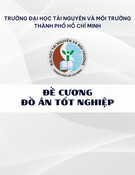
MINISTRY OF EDUCATION
AND TRAINING
VIETNAM ACADEMY
OF SCIENCE AND
TECHNOLOGY
GRADUATE UNIVERSITY SCIENCE AND TECHNOLOGY
----------------------------
Name Ph.D Tran Thi Thu Hien
RESEARCH ON SPECIES, DISTRIBUTION AND INTOXICANT
OF AMANITACEAE R.HEIM EX POUZAR IN HIGHLAND
MAJOR: Botany
Code: 9 42 01 11
SUMMARY OF BIOLOGICALDOCTORAL THESIS
HA NOI - 2018

This thesis was fulfilled at Graduate University of Science and
Technology, VietNam
Scientific instructor 1: Assoc. Prof. Dr. Tran Huy Thai
Scientific instructor 2: Assoc. Prof. Dr. Le Ba Dung
Reviewer 1: Prof. Dr. Pham Quang Thu
Reviewer 2: Assoc. Prof. Dr. Tran The Bach
Reviewer 3: Ph.D. Ha Minh Tam
The thesis will be defended in the Graduate University of Science and
Technology (GUST) council at Vietnam Academy of Science and
Technology (VAST) at …… on….. 2018
This thesis may be found at:
- The library of GUST
- National Library of Vietnam

1
INTRODUCTION
1. Significance of the research
Fungi were a saprophyte in the ecological enviroment. They could
extract enzyme to the enviroment to resolute complex molecules into
simple substances. Thus they play the important role into improve the
natural cycle of material circulation, mineralization of organic compounds,
freshing the ecological environment, increasing the fertility of the soil, so
increase crops and forest trees productivity.
The ecosystem in the Central Highlands is diverse with six main
ecosystem types, including tropical evergreen closed forest, deciduous
subtropical wet forest, deciduous semi-evergreen tropical forest, coniferous
mixed bamboo forest, grass and shrub, residential areas. Flora and founain
this area is very abundant, has many rare and precious species in Red Data
Book of Vietnam.
Nature condition in Central Highlands is convenient to
development of Fungi and Amanita genus. The research on large fungi is
very little, concentrated on midland area. In the Central highlands, there are
some research in South of Central highlands, the other areas almost has not
researched. Amanitaceae play the important role in the Fungi as a
diversities and special in poison, theses Fungi are highly toxic and easily
confused with some edible fungus.
The habit of using mushrooms in the wild and from the forest as
food is quite common to the people in the locality. This areas was
difficulties economic areas, living standard of the people is very low, most
of them are poor and dependent forest. Thus forest is a sources to provide a
food for living, among them mushroom is a the food that people say is a
specialty. Wild mushrooms was delicious and aromatic with very high
nutrients food. But it is also unfortunate confusion between the poisonous
mushrooms and edible mushrooms.

2
In the nature, there are alot of poisonous mushroom belong too
other genus susch: Amanita, Galerina, Lepiota, inobybe, Agaricus… eg:
The genus Amanita have Amanita verna, Amanita virosa, Amanita
phalloides… should be a confusion for people when using wild mushrooms
as food, in fact, there have been many cases of lethal fungal poisoning due
to lack of knowledge about poisonous mushrooms.
Inoder to provide the knowledge to the people who understand and
distinguish between the poisonous mushrooms and edible mushrooms is
very necessary. Thus, I have chosen the topic
“Research on species, distribution and intoxicant of Amanitaceae
R.Heim ex Pouzar in Highland”.
2. Research Objectives
- Identify some biological, ecological characterisitics of
Amanitaceae in Highland.
- Analyze intoxicant of some species in Amanita genus.
3. Scientific significance of the research
- Research on biological, ecological characterisitics Amanita genus.
- Supplement large mushroom list particulary in Highland and
Vietnam in general, simultaneously provide data basic for the other research
fields.
4. Practical significance of the research
Identify the poisonous mushrooms in the nature to prevent fungal
poisoning.
5. New result of the research
It is the first time to have a research on Amanitaceae, establish the
list of species of Amanitaceae in Highland. Identify the scienctific name of
23 species among 33 species and uses molecular biology to identify 16
species of this family in the Central Highlands. Introduce 15 species as a
new record for large fungi list of Vietnam and 8 species could be a new
species.

3
Research on biological, ecological characterisitics Amanita genus
- Establish the multivariate regression equation to focast the
distribution of Amanita species was Tansoxuathien = C + a*l + b*m +
c*h - d*t
- Determined the intoxicant of Amanita sp.1 to causing death of
experiment animal by oral with LD50 was 4750 mg/kg weight.
6. Chapter layout of thesis
This thesis is including 159 pages, 12 tables, 37 figures, 1 map and
index.
The sections of the thesis were: Index, list of tables, list of figures,
list of abbreviations, list of charts.
Introduction (5 pages); Chapter 1: Overview of publications (30
pages); Chapter 2: Subject, location, content and research methods (23
pages); Chapter 3: Research results (90 pages); Conclustion and
recommend (2 pages); List of published by the author related to the thesis
(2 pages); Refefences (8 pages); Index.
CHAPTER 1. OVERVIEW OF PUBLICATIONS
1.1. Fungi classification system
1.1.1. History of Fungi taxonomy
1.1.2. Basidiomycete and taxonomy system
1.1.3. Trinh Tam Kiet system
Div. Basidiomycota R. T. Moore (1980)
Fam. Amanitaceae R.Heinn ex Puozar (1983): 3 genus (+23
syns)
Characteristic: Fruit body is fleshy, easy to putrid. Cap is
umbrella shape, stalk central attached, easy to separate. Spore
radiation produce in the gill. Gill free. Spores glabrescent, no colour
in the microscope, pink when concentrated. Young fruit body has cover
by two membrance, scar when adult.
* Gen. Amanita Pers. (1987): Large distriobution, many species

![Tiểu luận Cơ sở Hóa sinh: Bài luận [Mới nhất]](https://cdn.tailieu.vn/images/document/thumbnail/2025/20250710/hoangmaiphuong_t66@hus.edu.vn/135x160/622_bai-tieu-luan-co-so-hoa-sinh.jpg)
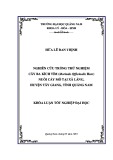
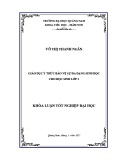

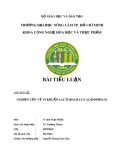
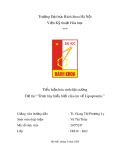
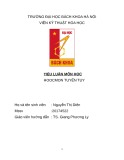
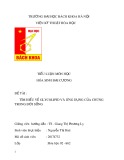
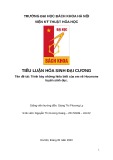
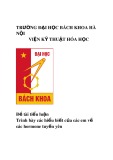
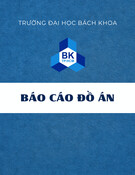
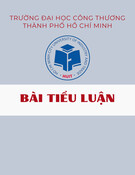
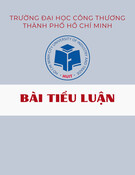
![Ô nhiễm môi trường không khí: Bài tiểu luận [Nổi bật/Chi tiết/Phân tích]](https://cdn.tailieu.vn/images/document/thumbnail/2025/20251011/kimphuong1001/135x160/76241760173495.jpg)
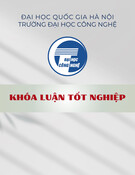
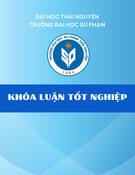
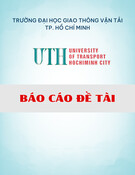


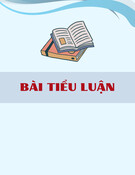
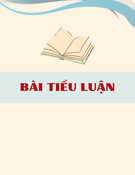
![Ứng dụng kỹ thuật trao đổi ion trong điện phân: Bài tiểu luận [chuẩn nhất]](https://cdn.tailieu.vn/images/document/thumbnail/2025/20250829/sonphamxuan1808/135x160/97341756442892.jpg)
